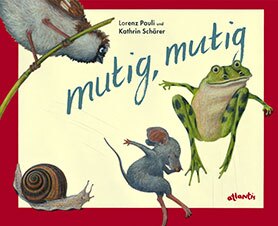Lorenz PauliKathrin Schärer
mutig, mutig
[How brave, how brave!]
- Atlantis Verlag
- Zürich 2006
- ISBN 3-7152-0518-0
- 32 Pages
- Publisher’s contact details
Lorenz Pauli
mutig, mutig
[How brave, how brave!]
This book was showcased during the special focus on Chinese (2005 - 2006).
Sample translations
How do you measure bravery?
Four friends meet by a pond. The mouse is there first, then the snail comes slithering along, the frog arrives with a bound, and finally the sparrow sticks his beak in as well and wonders what on earth they’re doing. In fact they’re doing nothing, just sitting there bored — until the frog has a brainwave: “Let’s have a competition to see who’s bravest!” They’re all excited by the idea, and each of them thinks up a particularly difficult task: the mouse swims across the pond and back under water, the frog eats a water lily, the snail leaves his shell, and the sparrow also does something that none of the others expect: he refuses to take part. To begin with, his companions are taken aback, and it takes quite a while before the penny drops — whereupon they are delighted and whoop with joy at the sparrow’s exceptional bravery.
This book by the tried and tested team of Lorenz Pauli and Kathrin Schärer shows in exemplary fashion how text and illustrations are capable not only of complementing but also of enhancing each other. The pictures begin to tell the story even before the written text begins. While Schärer’s animals retain their natural colouring, their faces have distinctly human features, and this helps younger children in particular to interpret their feelings. And there are plenty of feelings to interpret: the animals are bored, excited, offended, eager, sympathetic and mischievous — before ending up baffled and dumbstruck. Right at the very last however, thrilled by their realisation of just how brave the sparrow was, they are filled with sheer contentment. Schärer avoids over-elaborating the backgrounds of her illustrations, and hence the pond itself is only occasionally to be seen. The four animals are preoccupied exclusively with themselves, so their surroundings are rendered unimportant to the reader too.
Although the drawings are generally quite large-scale they also include many small details that make it worth paying them very close attention. The frog carries on rolling his eyes in disgust even after he has swallowed the water lily; a whole succession of images allows us to follow the snail’s long, slow journey around its shell; and the sparrow hums and haws and footles around before finally coming out with the fact that he’s not taking part.
Lorenz Pauli, too, sticks to essentials in his narrative. Once the frog’s suggestion has been enthusiastically accepted, the same pattern recurs with each successive animal. First, each proposed act of bravery is pooh-poohed by someone else in the group: the frog thinks there’s nothing to underwater swimming, the snail eats greens every live-long day, and the sparrow quit his shell on his first day of life. None of the contestants let themselves be put off, however, and it thus quickly becomes clear that what is easy for one requires bravery in another. The pattern of repetitions generates great expectancy as to what the sparrow will do — in the mind of the reader as also in the minds of the other characters in the story — and in consequence the surprise he springs is all the more effective.

This book by the tried and tested team of Lorenz Pauli and Kathrin Schärer shows in exemplary fashion how text and illustrations are capable not only of complementing but also of enhancing each other. The pictures begin to tell the story even before the written text begins. While Schärer’s animals retain their natural colouring, their faces have distinctly human features, and this helps younger children in particular to interpret their feelings. And there are plenty of feelings to interpret: the animals are bored, excited, offended, eager, sympathetic and mischievous — before ending up baffled and dumbstruck. Right at the very last however, thrilled by their realisation of just how brave the sparrow was, they are filled with sheer contentment. Schärer avoids over-elaborating the backgrounds of her illustrations, and hence the pond itself is only occasionally to be seen. The four animals are preoccupied exclusively with themselves, so their surroundings are rendered unimportant to the reader too.
Although the drawings are generally quite large-scale they also include many small details that make it worth paying them very close attention. The frog carries on rolling his eyes in disgust even after he has swallowed the water lily; a whole succession of images allows us to follow the snail’s long, slow journey around its shell; and the sparrow hums and haws and footles around before finally coming out with the fact that he’s not taking part.
Lorenz Pauli, too, sticks to essentials in his narrative. Once the frog’s suggestion has been enthusiastically accepted, the same pattern recurs with each successive animal. First, each proposed act of bravery is pooh-poohed by someone else in the group: the frog thinks there’s nothing to underwater swimming, the snail eats greens every live-long day, and the sparrow quit his shell on his first day of life. None of the contestants let themselves be put off, however, and it thus quickly becomes clear that what is easy for one requires bravery in another. The pattern of repetitions generates great expectancy as to what the sparrow will do — in the mind of the reader as also in the minds of the other characters in the story — and in consequence the surprise he springs is all the more effective.
Translated by Helena Kirkby

By Heike Friesel
